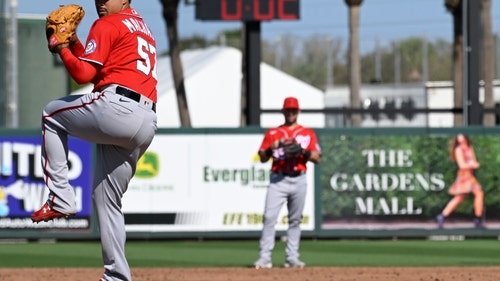
How long can Lincecum shoulder load?
At some point this month Tim Lincecum will join the ranks of the uber-rich. He’ll either win his arbitration against the Giants and be awarded a $13 million salary, or he’ll lose and have to live on a mere $8 million.
There’s little acrimony here because, one way or another, Lincecum is guaranteed to eat well in 2010. Of greater interest to both sides is how, specifically, a 25-year-old can possibly match his back-to-back Cy Young Award seasons.
The ceiling is already so high it’s unrealistic to think Lincecum can improve his strikeout ratio — he led the majors with 10.42 K’s per nine innings last year — or throw any harder. To the contrary, according to Fangraphs.com, Lincecum’s average fastball was down from 94.2 miles per hour in 2007 to 92.4 last year. By September, it had degraded to 91.
For all his success to date, Lincecum will have to prove he can withstand the rigors of a heavy workload. He leads the National League with 252 innings in the last two seasons. That includes 7,121 pitches, also tops in the NL.
Bigger, stronger pitchers have toppled under this kind of duress. Johan Santana threw more innings than anyone in the majors between 2004-2007 and paid for it in September with the second elbow surgery of his career.
Brandon Webb threw at least 226 innings for four straight seasons between 2005-2008 before finally breaking down in 2009. The list goes on, although Lincecum seems unconcerned. He says he’s never experienced even a twinge in his right arm.
Lincecum’s mechanics are so far acting as a buffer against injury; to say the Giants’ right-hander uses his entire body to deliver the ball is like saying Bill Gates has a checking account. Lincecum’s pitching stride reaches 7.5 feet, or roughly 129 percent of his height. The average stride length for a pitcher is 77 to 87 percent of his height.
That may explain why Lincecum was able to dodge the dreaded “Verducci Effect” in 2009. The theory, devised by Sports Illustrated’s Tom Verducci, suggested that a pitcher under 25 risks injury by increasing his workload by more than 30 innings from one year to the next.
Lincecum added 81.1 innings between 2007 and 2008, which means the Verducci Effect should’ve nailed him in ’09. But it didn’t. Lincecum leads the majors in ERA, batting average against (.214), winning percentage (.733) and strikeouts over the past two seasons.
But that’s not to say Lincecum can forever rely on pure velocity, as he’s already weaning off his fastball. In 2007, two out of every three pitches Lincecum threw were four-seam heat; the percentage declined to 55.8 percent last year. Conversely, his dependence on change-ups increased from 13.4 percent in ’07 to 21.4 percent in ’09.
That’s good news for the Giants, who are aware of the risks facing a 5-foot-10, 170-pound kid throwing pellets.
“Does it ever cross my mind that Tim’s eventually going to get hurt? Sure it does. I do worry,” pitching coach Dave Righetti said last year. “All the great ones eventually had something go wrong — (Tom) Seaver, (Bob) Gibson, (Jim) Palmer. But I’ll say this about Tim: he knows what he’s doing out there. This is what he’s been trained for, and he’s very, very disciplined about it.”
If nothing else, the combination of hard work and good genes make Lincecum a heavy favorite in the coming arbitration case. Even his recent brush with the law seemed to have matured him. After paying a $513 fine to settle a marijuana bust, Lincecum vowed to never smoke pot again. There’s no reason not to believe him.
Fact is, the Giants have virtually no ammunition against their young ace and are probably expecting to lose. GM Brian Sabean would pay that extra $5 million in a heartbeat if he thought it could keep Lincecum healthy now and for years to come.
The McGwire Debate (cont.)
Last week we wrote about the wide public relations gulf that separates Alex Rodriguez from Mark McGwire and why the Yankee slugger had largely been let off the hook in the steroids controversy.
We noted that, unlike McGwire, A-Rod was willing to name a complicit family member and talked about a specific timeframe during which he was juicing.
A few days later we were corrected by Ari Fleischer, the former White House press secretary who now has his own sports marketing firm and helped coordinate McGwire’s confession.
In an email, Fleischer wrote, “Mark told USA Today — which surprisingly was the only media outlet that asked — that his dealer in the 90s was his brother Jay. They reported that news almost two weeks ago. If Bob Costas had asked, Mark would have said it then as well.”
Fleischer also said McGwire deserves credit for coming forward voluntarily. The others who’ve confessed did so only after being outed.
Both points are well taken and we take responsibility for the omission. But McGwire’s campaign for forgiveness was sabotaged when he insisted steroids didn’t make him a superior home run hitter. If McGwire really wanted to make amends he should’ve been more honest.
Research done by the New York Post’s Joel Sherman reveals that before 1994 McGwire hit 7.14 home runs every 100 at-bats. After 1994, when by his own admission McGwire started using steroids more intensively, that ratio jumped to 11.88 HRs for every 100 at-bats. The previous record was 8.15, held by Babe Ruth.
That means McGwire turned into the Babe-plus immediately after he started injecting himself.
Coincidence? Not exactly.










